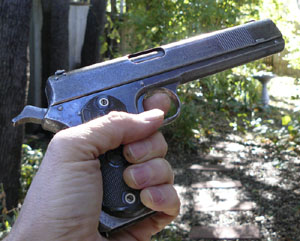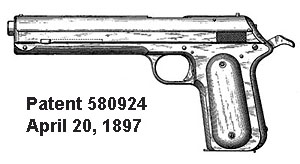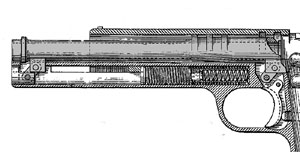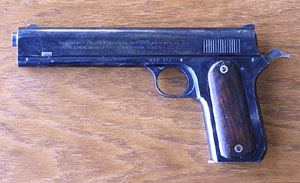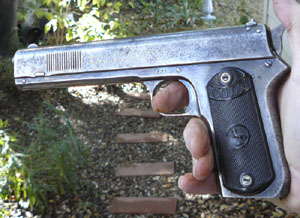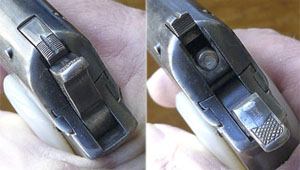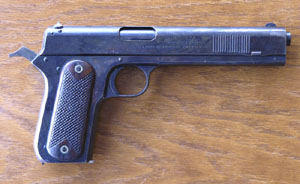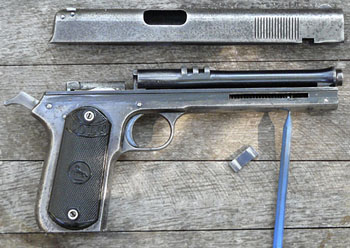 |
||||||||||||||||||||||||||||||||||||||||||||||||||||||||||||||
|
The First Colt Automatic Pistol by Ed Buffaloe The advent of automatic weapons had to wait for the invention of “smokeless” propellants, since black powder leaves so much residue it will quickly clog an automatic mechanism and render it inoperable. The first smokeless powder was introduced in 1884 by Paul Marie Eugène Vieille, a French chemist. Made from nitrocellulose, Vieille called his invention poudre blanche, or white powder, and it was generally referred to as Poudre B. Improvements came quickly. By 1900 there were several “smokeless” powders available. John Moses Browning began designing “automatic” or self-loading weapons late in 1889 after a seminal event that happened while he, his brothers and friends were out shooting. Will Wright, who was shorter of stature and hence closer to the ground than the tall Browning brothers, fired his gun and John Browning happened to notice that the high grass in front of him bent with the muzzle blast. The realization dawned for Browning that the muzzle blast represented energy that could be utilized to work the action of a gun. By the end of the next day, he had a working prototype to prove the concept. Browning filed his first patent on a gas-operated machine gun on 6 January 1890, and followed it with another dozen or so patents over the next decade on various types of self-loading weapons, both gas and recoil operated. In 1895 Colt’s began producing Browning’s machine gun, which marked the beginning of a long collaboration between John Browning and the Colt’s Patent Fire Arms Manufacturing Company. Browning’s first pistol patent was filed on 14 September 1895 and was followed just over a year later by three more pistol patents filed on 31 October 1896. All four U.S. patents were granted on 20 April 1897, having been given successive numbers:
In subsequent years Browning was granted further important U.S. pistol patents:
Not many people realize that John Moses Browning actually invented the reciprocating slide, which appears in approximately 99% of all modern self-loading handguns. In his 1897 patent he referred to it as a “moveable breech block or bolt carrier mounted to slide upon [the] frame.” The patent used the word “slide” as a verb but, as is so often the case, the verb became a noun for the item whose action it described. The second government report on the Colt Automatic Pistol, dated 28 April 1900 referred to it as “A sliding cover,” and later as simply “the slide.” The First Colt Automatic Pistol Colt’s first automatic pistol was based on Browning’s patent №580,924 of 1897. Browning completed a prototype of this pistol early in 1896, chambered for a .38 caliber rimmed revolver cartridge, and showed it to the Colt’s people in Hartford in May-June of that year. Colt’s immediately saw the possibilities Browning’s design held for military applications. It could fire seven rounds in less than a second and a half, and with a muzzle velocity much higher than most revolvers of the day. The fact that it was chambered for a .38 caliber cartridge made no difference at the time, since the Colt Double Action Army Revolver in .38 Long Colt had been adopted by the U.S. Army in 1892, and its inadequacies had not yet become apparent.
Browning and Fred Moore of Colt continued improving the design from late 1896 through 1898. A fully automatic prototype was manufactured at the Colt factory, but it proved impossible to control and was abandoned. During this same period, Browning developed a “rimless” cartridge for the gun (it was actually a semi-rimmed cartridge), but few details of its development are available. The cartridge was known as the .38 ACP (Automatic Colt Pistol) or the .38 Auto and was less powerful than the 9mm Parabellum, though it had a longer case. Muzzle velocity was between 1050 and 1150 feet per second, depending on the weight of the bullet. The .38 ACP was superseded in 1929 by the .38 Super, which uses an identical brass case but with a heavier powder load. The .38 Super generates a muzzle velocity that is 25-30% higher than the .38 Auto, and delivers 50-60% more energy. .38 Super cartridges should not be fired in the early Colt .38 Auto pistols, but the cases can be reloaded at appropriate levels and will function perfectly well in the older guns. Loading data can be found in various reloading publications and in Cartridges of the World. However, great care must be taken not to overload cartridges for the early Colt autos. A prototype of the pistol was provided to the United States Ordnance Department on 9 November 1898, and it was examined and tested on 11 November, along with four other automatic pistols. The board of officers reported that “The Board is of the opinion, based upon a careful examination of the Borchardt, the Mannlicher, the Mauser, the Colt, and the Bergmann repeating weapons, that the development of this type of pistol has not yet reached such a stage as to justify its adoption in the place of the revolver for service use...” In September of the next year, Colt was requested to submit another pistol for further testing in November, but was unable to deliver it until mid-January of 1900. No spare parts were provided, as the gun was not yet in full production.
Authorization was given, and 100 of the Colt Automatic Pistols were purchased by the Ordnance Department on 10 May 1900, for testing by the Army, and were delivered between 16 May and 1 June. However, to Colt’s probable chagrin, the Ordnance Department also placed an order for 1000 7.65mm Luger Parabellum pistols. On 5 September 1900 the Navy ordered 250 of the Colt Automatic Pistols, and deliveries were completed by 29 October. A second Army order for 200 pistols was placed on 19 December 1900, after some recommended improvements had been made, and deliveries were complete by 4 February 1901. The earliest batch of Army pistols was sent to officers in the Philippines, Cuba, and Puerto Rico for testing. The consensus was that the pistol was muzzle heavy, and ultimately it was recommended that the grip should be lengthened so the gun could be grasped more securely, which would also increase the magazine capacity, but the Army recognized this would require some redesign and retooling at the factory. It was also noted that the gun required two hands to chamber a round for the first shot and, if it should be carried with a round chambered and the safety on, the safety was inconveniently placed for one-handed disengagement. An easier means of disassembly, which did not require a separate tool, was desired. Other recommendations were that the slide serrations should be moved to the front of the slide, and that the grip panels should be widened and/or checkered--these recommendations were implemented for the second batch of pistols sent to the Army. Some thought a lanyard ring or swivel would be a good idea. After the slide serrations were moved to the front of the slide on the second batch of Army pistols, an officer noted that he still couldn’t get a good purchase on them if they were oiled, and he recommended the serrations be replaced by checkering. Quite a few broken firing pins were reported during the Army testing.
The gun has come to be called the model 1900 Colt, but “Model 1900” was never an official designation of Colt’s, which simply called the gun the Colt Automatic Pistol. It was marked on the right side as follows: AUTOMATIC COLT On the left side it was marked: “BROWNING’S PATENT” COLT’S PATENT FIRE ARMS MFG. CO.
The sight safety was criticized for a number of reasons. The cut in the firing pin into which the sight safety fitted weakened the pin at a critical point (one actually broke during the government test in 1900, and quite a few were broken during later Army tests) and the entire mechanism was overly complex and required otherwise unnecessary small pins and a spring. Target shooters didn’t like the sight picture because the rear sight was too high and narrow, and the spur hammer interfered with the sight picture unless the hammer was cocked. It quickly became apparent that the non-inertial firing pin was a problem. Its tip rested on the back of the cartridge primer, and should the sight safety not be engaged, or should it fail, the gun could fire if dropped. Many of the early production guns had the sight safety removed at a later date to make the gun more shootable, and it was eliminated entirely from late production guns. When the sight safety was removed a bronze inertial firing pin was installed that had a spring that prevented the tip of the firing pin from resting on the primer. A metal filler plate was inserted in place of the sight safety and the transverse pin the safety had pivoted on was used to retain the plate. A dovetail slot was milled in the top of the gun to install a conventional rear sight. Some guns which were returned to the factory to have the sight safety removed also had a concave spring-loaded take-down plug installed in front of the recoil spring which allowed the gun to be dismantled by pressing in on the plug instead of requiring a separate pin or drift punch. The guns originally came with a fixed plug which was convex. Colt also developed a “stub” hammer with no cocking spur, which was installed on some production pistols after 25 April 1901.
The gun weighs 37 ounces, is 9 inches long, and has a 6 inch barrel. The magazine holds 7 rounds. Approximately 4274 total guns were made between February of 1900 and May of 1902. The same slides continued to be made for the Model 1902, but the 1902 slides had no slot milled at the rear for the sight safety. All of the 1900 Colt Automatic Pistols were numbered consecutively. The serial numbers were engraved or stamped on the left side of the frame, above the trigger guard, and a matching number was stamped inside the slide. The first 70 or so pistols had hand engraved serial numbers. R.K. Wilson said of the gun: “It is quite a pleasant pistol to shoot with, though the butt is rather square to the barrel and it is somewhat muzzle heavy.”
Comparison to Other Early Auto Pistols Ferdinand Mannlicher had begun producing automatic pistols as early as 1894, but none was commercially successful until the Steyr-Mannlicher of 1900. Theodor Bergmann had likewise begun manufacturing automatic pistols as early as 1894, but again none was truly commercially successful until the Bergmann Mars of 1903. The most successful pistol of the era was the Mauser C96 “Broomhandle,” which appeared in 1896, and sold over a million copies by 1937. Both the Bergmann and Mauser pistols were accurate, reliable, and sufficiently powerful locked breech military weapons, but they were clumsy to operate, unwieldy to carry, and mechanically complex. The 1900 Mannlicher handled very well and was mechanically simple. However, it was not a true locked breech pistol, and was significantly underpowered for a military weapon. The Mauser and Mannlicher were both clip-loaded, whereas the Bergmann had a removeable box magazine. Browning’s designs were always noted for their simplicity, and the 1900 Colt was a prime example. The firing mechanism consisted of the trigger, sear, hammer, firing pin & spring, disconnector, main spring, a few pins, and two screws. The gun field stripped in a few seconds to four components. It was powerful, accurate, reliable, and handled well with the exception of being somewhat muzzle heavy. It was far easier to carry than the Mauser or Bergmann. While it was not a huge commercial success, it lay the foundation for, and eventually evolved into, what many shooters in the U.S. consider the most successful military pistol of the 20th century, the Colt 1911. |
||||||||||||||||||||||||||||||||||||||||||||||||||||||||||||||
|
Copyright 2008 by Ed Buffaloe. All rights reserved. |
||||||||||||||||||||||||||||||||||||||||||||||||||||||||||||||
|
||||||||||||||||||||||||||||||||||||||||||||||||||||||||||||||
|
|
||||||||||||||||||||||||||||||||||||||||||||||||||||||||||||||
